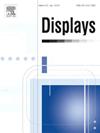Low scattering and fast response polymer brush-stabilized liquid crystal microlens array with tunable focal length
IF 3.7
2区 工程技术
Q1 COMPUTER SCIENCE, HARDWARE & ARCHITECTURE
引用次数: 0
Abstract
Introducing polymers into liquid crystal (LC) devices is an effective way to increase the response speed, but it can also cause additional scattering. A scattering-free and fast-response LC microlens array (LCMLA) based on surface-initiated polymerization (SIP) is demonstrated. Unlike the conventional fabrication of the polymer network liquid crystal (PNLC), the initiator is encapsulated in an alignment layer on the surface of the substrate, separate from the reacting monomers. Ring array patterned electrodes, carefully designed, generate a non-uniform electric field, which in turn induces a gradient refractive index distribution in the LC layer. Upon UV polymerization, the reaction initiates at active sites on the surface, and polymer fibers grow directionally from the substrate, resembling bush-like structures confined to the surface layer. LCMLAs fabricated using this method exhibits a haze of only 13.8 %, offering higher transmittance compared to conventional PNLC MLA. Due to these characteristics, the polymer brush-stabilized liquid crystal (PBSLC) MLA has better imaging performance. Additionally, the response time of the PBSLC MLA is 2.32 ms. Consequently, this PBSLC MLA hold significant potential for applications in the optical communication, fast-switching displays, beam steering and adaptive optics.
低散射、快速响应、可调焦距聚合物电刷稳定液晶微透镜阵列
在液晶(LC)器件中引入聚合物是提高响应速度的有效方法,但也会引起额外的散射。提出了一种基于表面引发聚合(SIP)的无散射快速响应LC微透镜阵列(LCMLA)。与传统的聚合物网络液晶(PNLC)制造不同,引发剂被封装在衬底表面的对准层中,与反应单体分离。精心设计的环形阵列电极产生非均匀电场,从而在LC层中诱导梯度折射率分布。在UV聚合时,反应在表面的活性位点开始,聚合物纤维从基底定向生长,类似于被限制在表层的灌木状结构。与传统的PNLC MLA相比,该方法制备的lcmla的雾度仅为13.8%,具有更高的透光率。由于这些特点,聚合物电刷稳定液晶(PBSLC) MLA具有更好的成像性能。PBSLC MLA的响应时间为2.32 ms。因此,这种PBSLC MLA在光通信、快速开关显示、光束转向和自适应光学方面具有重要的应用潜力。
本文章由计算机程序翻译,如有差异,请以英文原文为准。
求助全文
约1分钟内获得全文
求助全文
来源期刊

Displays
工程技术-工程:电子与电气
CiteScore
4.60
自引率
25.60%
发文量
138
审稿时长
92 days
期刊介绍:
Displays is the international journal covering the research and development of display technology, its effective presentation and perception of information, and applications and systems including display-human interface.
Technical papers on practical developments in Displays technology provide an effective channel to promote greater understanding and cross-fertilization across the diverse disciplines of the Displays community. Original research papers solving ergonomics issues at the display-human interface advance effective presentation of information. Tutorial papers covering fundamentals intended for display technologies and human factor engineers new to the field will also occasionally featured.
 求助内容:
求助内容: 应助结果提醒方式:
应助结果提醒方式:


